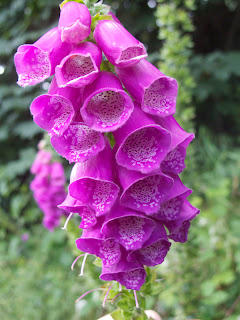On this occasion my friend Mick Carney www.thepaintingstruggle.blogspot.com/ chose the subject.
I studied this for quite some time before deciding how to proceed. The obvious feature is the pink Hollyhock, which hits you in the eye and the background is blurred. Various shades of green, from blue-green to yellow-green. Pink and green - compliments. One of the things I have noticed, in studying the array of wonderful artists who display their paintings on Facebook is the use of compliments.
This was a preliminary experiment with no drawing just to see how the colours worked together.
Version 1
In this one the colours were Quinacridone Coral (DS PR209) and Permanent Magenta (Rowney PV19 violet shade) for the flower and Sap Green, Hookers Green, Green-Gold and Cobalt Teal Blue for the background.
Version 2
Here the flower colours were similar but the background included Translucent Orange (Schminke PO71), Quinacridone Burnt Orange (DS PO48), with Hookers Green omitted. The Schminke Translucent Orange was used on Jean Haines recommendation via her latest book and I also studied one of her most recent paintings (unfinished I think), which includes Hollyhocks. Back to the drawing board?
Jean Haines
Version 3 - The Final One!
16" x 12" Fabriano Artistico Extra White 140lb (300gsm) Not
This is the third version and I don't think I'll do another - regardless! The Hollyhock colours are mainly Quinacridone Coral (DS PR209), Quinacridone Fuschia (DS PR202), a little Permanent Magenta (Rowney PV19 Violet Shade) and Quinacridone Rose (Graham PV19). The background colours are Sap Green (DS PO49/PG7), Cobalt Teal Blue (Daniel Smith PG50) and Green Gold (Rowney PY129).
I basically used one brush, The Da Vinci Artissimo 44 Size 2 Kolinsky mop, roughly equivalent to a round 12/14. It has a full body and sharp point.
Note:You may notice that the painting appears square (16" x 16") despite the original being 16" x 12". No matter what I do I'm unable to change this. Yvonne suggested taking the photograph in landscape format and leaving a margin at either side. This doesn't seem to work either. My two cameras are a Canon SX120 Digital and a Nikon DSLR with 55mm lens. It makes no difference whichever I use. Has anyone any idea how I can overcome this? The result is that paintings that are in portrait format always look squashed. Landscape format is unaffected. Added 31/08/12: It would seem that my monitor may be the problem.





























.jpg)
























